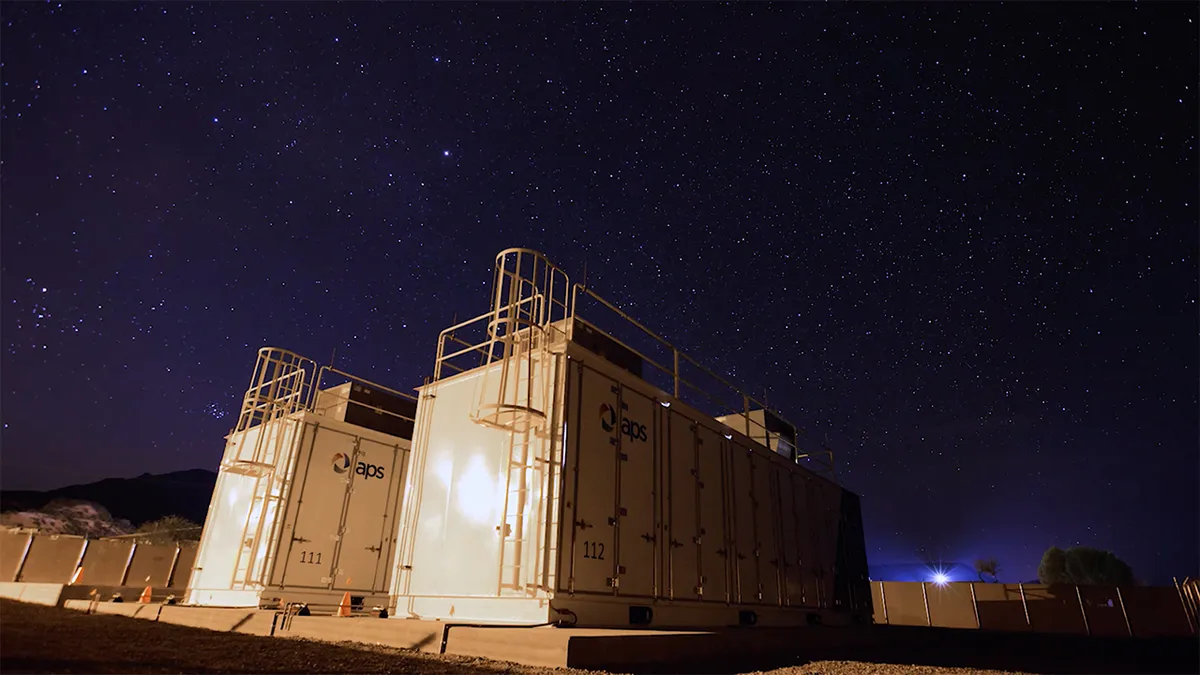Dive Brief:
- Battery maker LG Chem disputed a claim in an Arizona Public Service (APS) July report identifying an internal cell defect as the root cause of the April 2019 explosion at APS's McMicken battery energy storage facility in Surprise, Ariz. The report prepared for APS by DNV-GL pointed to cell failure in a single battery as initiating the thermal runaway event.
-
In analysis performed for LG Chem by Exponent, an external heat source, such as external electrical arcing was identified as a possible cause. "The facts of the incident that have been established to a reasonable degree of scientific rigor, together with relevant peer-reviewed literature, rule out the initiating cause proposed by DNV-GL," LG Chem said in comments submitted to the Arizona Corporation Commission.
-
Battery energy storage systems (BESS) are continuously being tested and global safety certification company UL LLC has created a number of standards for construction and testing based on its research. UL "has been conducting research on safety of lithium-ion batteries and energy storage systems for over a decade, including significant research on thermal runaway and fire characterization of energy storage systems," Ken Boyce, principal engineer director in UL's Energy and Power Technologies division, said in an email.
Dive Insight:
LG Chem pointed out in its comments that the author of APS's final report did not conduct site visits or forensic analysis of site artifacts, but summarized findings of APS's retained consultants. "The independent experts retained by LG Chem believe that the evidence rules out DNV-GL's theory regarding the cause of the initial thermal runaway event," Kyunghyun Nahm, deputy general counsel for LG Chem, said in a letter to the commission.
APS declined to comment on methods or findings in LG Chem's report. Davion M. Hill of DNV-GL, author of the APS report submitted July 27, would not comment for the company.
APS and LG Chem agree that the explosion occurred when firefighters opened a door, igniting flammable gases accumulated inside the battery energy storage system (BESS) container. Four firefighters were injured and two have not yet returned to work, said Rick Swan, director of health and safety operational services for the International Association of Fire Fighters (IAFF).
There is no method yet for stopping a thermal runaway event in a BESS installation, according to Swan. "Industry can sometimes get ahead of themselves," he said.
Both APS and LG Chem agreed the Novec 1230 clean agent fire-suppression system installed in the McMicken facility was inadequate to halt the thermal runaway event.
Firefighters' concerns about energy storage systems include being informed by system owners about materials inside containers, ongoing monitoring and having detailed emergency response plans, Swan said.
"Additional research on effective fire service tactics, remote gas monitoring, robust communication systems, and explosion prevention systems are needed," Steve Kerber, vice president of research at UL Firefighter Safety Research Institute (FSRI), said in an email.
Kerber's team at FSRI released a report July 29 detailing the incident at APS's 2.16 MWh lithium-ion BESS facility in Surprise. The UL research team interviewed officers and crew members of the Surprise Fire-Medical Department who responded to the incident and three of the four members of the Peoria Fire-Medical Department Hazardous Materials (hazmat) team injured at the scene.
"Utility and energy storage system developers should work with the fire service to fill the knowledge, education and research gaps that have been identified as a result of this accident and subsequent investigations," Kerber said.
Kerber suggested several steps utilities and energy storage system developers should take to protect firefighters and hazardous materials response teams, including:
- Developing an emergency operations plan in conjunction with local fire service personnel based on a comprehensive understanding of the hazards associated with lithium-ion battery technology;
- Requiring signage on all BESS installations that identifies the contents of the BESS, alerting first responders to the potential hazards associated with the installation;
- Conducting full-scale testing to determine the most effective fire-suppression and explosion-prevention systems for lithium-ion BESS; and
- Conducting full-scale testing to understand the most effective and safest tactics for fire crews and hazmat response teams to use in lithium-ion BESS incidents.
Firefighters are looking to battery makers, BESS developers, and utilities to tell them how to best handle events at BESS installations, IAFF's Swan said.
A spokesperson for the National Fire Protection Association said NFPA would not comment on an incident it had not investigated. BESS developer Fluence did not respond to requests for comment.
Commissioner Sandra Kennedy raised concerns in August 2019 about the use of lithium-ion battery chemistry in the wake of the APS fire. Her office did not respond to a request for comment.














